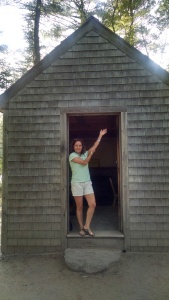Today was a busy day! We actually arrived in Concord, Massachusetts yesterday, and even though we didn’t have much time, we went to Walden Pond first, where Ann and Jen hiked to the site of the cabin of Henry David Thoreau (THAR-ow — yes, they do say it like that, repeat after me: THAR-ow). I sat on the beach and tried my best not to shiver while other people actually swam in the cool water. At dusk, to save time, we rode over to Sleepy Hollow Cemetery to gaze on the graves of Louisa May Alcott, Thoreau, Nathaniel Hawthorne, and Ralph Waldo Emerson.

Today brought us rain, darkening both the sky and our literary ambitions. The Old Manse (built by Emerson’s father and home to Hawthorne and his family for a while) and The Wayside (the only house actually owned by Hawthorne) were CLOSED! We compensated with a little historic detour, driving over to the site of the Battle of the North Bridge, otherwise known as the “shot heard round the world.”
Fortunately, the Concord Museum opened at 9 a.m., and there we saw one of Paul Revere’s lanterns and Emerson’s actual study, which had been completely reassembled (books and all) within the walls. We also toured The Orchard, the house owned by the Alcott family, and I stood inches away from the desk used by Louisa as she penned the bestselling Little Women. We gently snickered at the way our Northern friends pronounced Raleigh (RAWL-eee).
Hungry for more Hawthorne, we decided to drive to Salem, the place of his birth and where he lived for a while. There we toured The House of Seven Gables, the house of his cousin Susanna and where he drew inspiration for his famous novel. While the incidents in the novel were fictional, the eventual restorer of the site took great pains to honor the novel by representing how the house may have appeared in the tale, even inserting a secret staircase in the chimney which might have been used by Clifford, one of the main characters. A highlight for me was seeing the actual desk where Hawthorne wrote another masterpiece, The Scarlet Letter.

Being 3 p.m. and safely out of the rush hour traffic, we decided to next try our luck in Boston, a little ahead of schedule. I was a useless navigator for our driver, brave and dedicated Jen, who persevered against the rain and unyielding drivers to get us safely to our destination.
(Drivers beware. If Jen calls you “buddy” or “sweetheart,” such as “Get out of my way, buddy!” this is not a term of endearment.)
Although the rain did not cease, Boston still gleamed. Here history and literature converged again. Forgoing a tour of Paul Revere’s house, Faneuil Hall and much more, we focused instead on just a few literary highlights, as you can see below. See you tomorrow, as we make our way to Provincetown.


